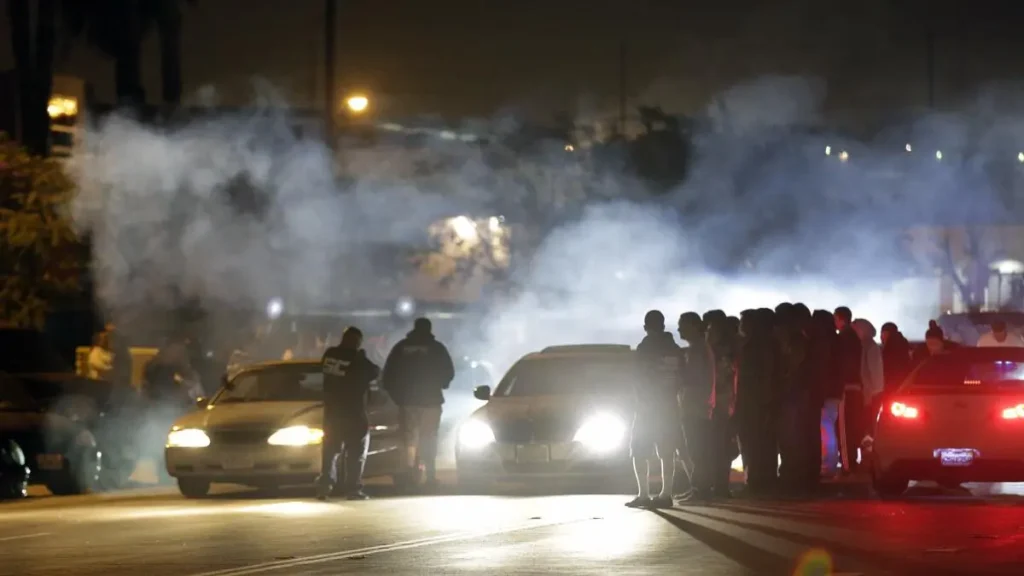Street racing, an illegal and dangerous high-speed competition on public roads, poses a significant threat to the safety of both participants and unsuspecting spectators.
Driven by adrenaline and excitement, this underground culture often develops in the shadows of city streets, turning city roads into impromptu racetracks.
Consequences of Street Racing
This study delves into the world of street racing and explores the reasons behind this dangerous practice, its consequences, and the measures needed to curb this dangerous behavior.
1. The Magic of Street Racing:
Street racing has captivated thrill seekers for decades, drawing them into an adrenaline-filled world of speed and competition. The magic lies in the visceral experience of pushing vehicles to their limits, the thrill of high-speed chases, and the thrill of overtaking opponents in an illegal race on city streets. The underground nature of street racing adds to the rebellion and attracts people seeking excitement outside of legal venues.
2. Risks and Consequences:
The risks associated with street racing are multifaceted and extend far beyond the immediate participants. High speeds, unpredictable movements, and a lack of safety measures increase the likelihood of catastrophic accidents. Innocent bystanders and other motorists become unintended targets that can cause life-threatening injury or death. The consequences of street racing are serious and include legal ramifications, vehicle impoundment, and permanent emotional trauma for those affected by the reckless actions of street racers.
3. The Role of Popular Culture:
Popular culture, including movies, television shows, and video games, has played a role in romanticizing speeding on roads. While entertainment media often portrays high-stakes racing in a cinematic manner, it fails to highlight the real dangers and legal consequences of such activities. Considering the influence of popular culture in shaping perceptions of overspeeding in the streets is crucial to developing strategies to prevent people from engaging in this dangerous activity.
4. Illegal street speeding:
Such events, often held in secret, attract participants and spectators. These events range from impromptu meetings on individual streets to coordinated competitions in industrial areas. The secretive nature of these breeds makes it difficult for law enforcement agencies to effectively prevent and treat the problem. Breaking up illegal street racing requires a multi-pronged approach that includes increased policing, community involvement, and targeted efforts to disrupt organized racing.

5. Need for enforcement:
Law enforcement agencies play a key role in curbing street racing. Stepping up enforcement efforts includes deploying resources to known hotspots, using technology like surveillance cameras, and working with communities to gather intelligence. Severe penalties for those caught in street racing, including fines, license suspension, and possible jail time, act as a deterrent and emphasize the seriousness of the crime.
6. Community involvement and education:
Community involvement is an integral part of street racing. Cooperation between law enforcement, local authorities, and community leaders can foster an environment where individuals understand the dangers of street racing and work together to prevent such activity. Educational campaigns targeting schools and local communities can raise awareness of the consequences of street racing and emphasize the need for responsible driving behavior.
7. Infrastructure planning and traffic-calming measures:
Urban infrastructure planning can play a role in preventing street racing. The implementation of traffic-calming measures such as traffic barriers, improved signage, and strategically placed road sections can prevent speeding. These design elements aim to create a safer road environment and prevent street racers from selecting certain areas for their reckless activities.
8. Vehicle Modifications and Inspections:
Many street racers modify their vehicles to increase speed and efficiency, often making them unsafe on public roads. Stricter vehicle modification regulations, along with regular inspections, could reduce the use of illegally modified cars in street racing. This approach tackles the problem at its source by limiting access to vehicles that pose a greater risk on public roads.
9. Legal Alternatives to Racing:
Providing legal alternatives to racing enthusiasts is an integral part of street racing. Establishing designated racetracks with appropriate security measures allows people to satisfy their need for speed in a controlled and regulated environment. Creating routes for legal competition not only channels the enthusiasm of racing enthusiasts but also discourages potential participants from engaging in illegal activities on public roads.
10. Technical measures:
The development of technology offers possible interventions to curb street competition. GPS tracking and speed limit technologies can be integrated into vehicles to monitor and limit speed in certain areas. In addition, automated enforcers such as red light cameras and speed cameras can be used strategically to discourage and penalize street racing.
11. Rehabilitation programs:
Rehabilitation programs can be an alternative to punitive measures for people suspended from street racing. These programs may include education about the consequences of reckless driving, counseling for impulsive behavior, and community service to emphasize the role of a responsible citizen. Offender rehabilitation addresses the root causes of street competition and aims for long-term behavioral changes.
Conclusion:
Street racing, with its dangers and widespread consequences, requires a comprehensive and cooperative approach to curb its spread. By embracing the appeal of street racing, strengthening enforcement, engaging communities, and implementing proactive strategies, society can work to create safer urban roads. The fight against street racing requires the commitment of law enforcement agencies, communities, policymakers, and individuals to work together to create an environment where the need for speed is met responsibly and without endangering the lives of other road users.
